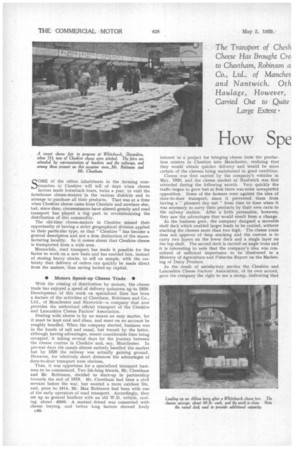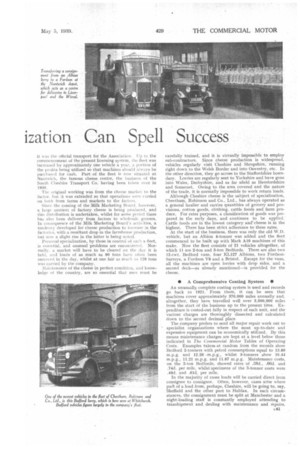How Six ization Can Spell Success
Page 90

Page 91

If you've noticed an error in this article please click here to report it so we can fix it.
SOME of the oldest inhabitants in the farming communities 01 Cheshire will tell of days when cheese factors made horseback tours, twice a year, to visit the farmhouse cheese-makers in the various districts and to arrange to purchase all their products. That was at a time when Cheshire cheese came from Cheshire and nowhere else, but, since then, circumstances have altered greatly and road transport has played a big part in revolutionizing the distribution of this commodity.
The old-time cheese-makers in Cheshire missed their opportunity of having a strict geographical division applied to their partiellar type, so that " Cheshire " has become a general description and not a firm distinction of the manufacturing locality. So it comes about that Cheshire cheese is transported from a wide area.
Meanwhile, road transport has made it possible for the factor to work on a new basis and has enabled him, instead of storing heavy stocks, to sell on sample, with the certainty that delivery of orders can quickly be made direct from the makers, thus saving locked-up capital.
• Motors Speed-up Cheese Trade •
With the coming of distribution by motors, the cheese trade has enjoyed a speed of delivery unknown up to 1920. Development of this work on specialized lines has been a feature of the activities of Cheetham, Robinson and Co., Ltd., of Manchester and Nantwich—a company that now provides the authorized official transport of the Cheshire and Lancashire Cheese Factors' Association.
Dealing with cheese is by no means an easy matter, for it must be kept cool and clean, and must on no account be roughly handled. When the company started, business was in the hands of rail and canal, but transit by the latter, although having advantages, meant considerable time being occupied, it taking several days for the journey between the cheese centres in Cheshire and, say, Manchester. In pre-war days the canals almost entirely handled the market but by 1920 the railway was actually gaining ground. However, for relatively short distances the advantages of door-to-door transport were obvious.
Thus, it was opportune for a specialized transport business to be commenced. Two life-long friends, Mr. Cheetham and Mr. Robinson, decided to start-up in partnership towards the end of 1919. Mr. Cheetham had been a civil servant before the war, but wanted a more outdoor life, and, prior to 1914, Mr. Max Robinson had been with one of the early operators of road transport. Accordingly, they set up as general hauliers with an old W.D. vehicle, costing about £900. A mutual friend was connected with cheese buying, and before long factors showed lively
c90-
interest in a project for bringing cheese from the production centres in Cheshire into Manchester, realizing that they would obtain quicker delivery and would be more certain of the cheeses being maintained in good condition. Cheese was first carried by the company's vehicles in May, 1920, and the cheese market at Nantwich was first attended during the following month. Very quickly the traffic began to grow but at first there was some unexpected opposition. Some of the farmers were against the idea of door-to-door transport, since it prevented them from having a "pleasant day out" from time to time when it was necessary to carry their products by their own carts to the railway station. After a little persuasion, however, they saw the advantages that would result from a change.
As the business grew, the company designed a movable shelf deck which enabled larger loads to be carried, without stacking the cheeses more than two high. The cheese trade does not approve of deep stacking and the custom is to carry two layers on the lower deck and a single layer on the top shelf. The second deck is carried on angle irons and it is interesting to note that the company's idea was considered of sufficient importance to be illustrated in a Ministry of Agriculture and Fisheries Report on the Marketing of Dairy Produce.
As the result of satisfactory service the Cheshire and Lancashire Cheese Factors' Association, of its own accord, gave the company the right to use a stamp, indicating that it was the official transport for the Association. Up to the commencement of the present licensing system, the fleet was increased by approxiinately one vehicle a year, a portion of the profits being utilized so that machines should always be purchased for cash. Part of the fleet is now situated at Nantwich, the famous cheese centre, the business of the South Cheshire Transport Co. having been taken over in 1930.
The original working was from the cheese market to the factor, but it was extended so that operations were carried on ht h from farms and markets to the factors.
Since the coming of the Milk Marketing Board, however, a large amOunt of factory cheese is being produced, and this distribution is undertaken, whilst for some period there has also been delivery from factors to wholesale grocers. In consequence of the Milk Marketing Board's activities, a tendency developed for cheese production to increase in the factories, with a resultant drop in the farmhouse production, but now a slight rise in the latter is being noted.
Personal specialization, by those in control of such a fleet, is essential, and unusual problems are encountered. Normally, a market will have to be cleared on the day it is held, and loads of as much as 90 tons have often been removed in the day, whilst at one fair as much as 128 tons was carried by the company. Maintenance of the cheese in perfect condition, and knowledge of the country, are so essential that men must be carefully trained, and it is virtually impossibIe to employ sub-contractors. Since cheese production is widespread, vehicles regularly visit Cheshire and Shropshire, running right down to the Welsh Border and into Oswestry, etc. In the other direction, they go across to the Staffordshire boundary. Lorries are regularly sent to Yorkshire and have gone into Wales, Derbyshire, and as far afield as Herefordshire and Somerset. Owing to the area covered and the nature of the trade, it is normally impossible to work return loads.
Although Cheshire cheese is the subject of specialization, Cheetham, Robinson and Co., Ltd., has always operated as a general haulier and carries quantities of grocery and provisions, cotton goods, clothing, cattle foods and farm produce, For rates purposes, a claSsification of goods was prepared in the early days, and continues to be applied. Cattle foods are in the lowest category and cheese is in the highest. There has been strict adherence to these rates. At the start of the business, there was only the old W.1). vehicle, but an Albion 4-tonner was added and the fleet commenced to be built up with Mark A10 machines of this make. Now the fleet consists of 21 vehicles altogether, of which 11 are 2-ton and 3-ton Bedfords. There are also two 12-cwt. Bedford vans, four KL127 Albions, two ForclsonSurreys, a Fordson V8 and a Bristol. Except for the vans, all the machines are open lorries with drop sides, and a second deck—as already mentioned—is provided for the cheese.
• A Comprehensive Costing System 0 An unusually complete costing system is used and records go back to 1921. From them, it can be seen that machines cover approximately 370,000 miles annually and, altogether, they have travelled well over 3,500,000 miles from the start of the business up to the present time. Expenditure is costed-out fully in respect of each unit, and the various charges are thoroughly dissected and calculated down to the second decimal place The company prefers to send all major repair work out to
specialist organizations where the most up-to-date and expensive equipment can be economically utilized. By this means maintenance charges are kept at a level below those indicated in The Commercial Motor Tables of Operating Costs. Examples takens at random from the records show Bedford 2-tonners with petrol consumptions equal to 13.86
m.p.g. and 12.26 whilst 3-tonners show 10.44 m.p.g., 11,21 m.p.g. and 11.67 m.p.g. Maintenance costs, on the 2-ton Bedfords, showed rates of .38d., .66d. and .74d. per mile, whilst specimens of the 3-tonner costs were .49d. and .61d. per mile.
In the majority of cases loads will be carried direct from consignee to consignor. Often, however, cases arise where parl of a load from, perhaps, Cheshire, will be going to, say, Sheffield and the other part to Halifax. In such circumstances, the consignment must be split at Manchester and a night-loading staff is constantly employed attending to transhipment and dealing with maintenance and repairs.
































































































































































